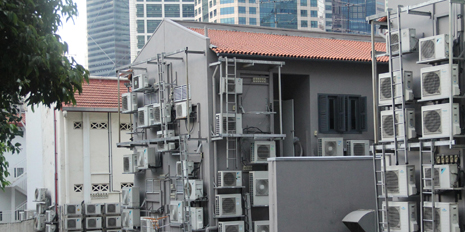Cooling Singapore
Air conditioning is one of the daily necessities and irritations of life in Singapore. Since cooling systems account for over a third of the electricity consumed in Singapore, using it very inefficiently, there is a clear need to improve them.

In a hot, humid climate, you can hardly live without air conditioning, yet working in a dry, over-chilled room is tiring and uncomfortable. Also, air-conditioners, especially those mounted in the walls of high-rise buildings, are ugly and noisy, and make the city even warmer by blasting out hot air. Striving for a sustainable future, we need to develop more energy-efficient technologies to cool Singapore and other tropical cities.
New technologies for efficient cooling systems
Members of the Low Exergy module of Future Cities Laboratory (FCL) are attempting to improve cooling systems using a range of technologies developed at ETH to increase the efficiency of space heating. These include radiant heat exchange (which works rather like under-floor heating but in reverse: the floor and ceiling absorb heat), decentralized ventilation (each room receives its own independent ventilation unit, integrated into the façade), and wireless sensors and controls that measure the temperature and adapt air-conditioning individually for every room. The preliminary results are very promising, suggesting that the energy needed for cooling can be reduced by as much as 60%. And there is another important benefit: the new systems need much less space for ducting and machinery, so that buildings can be smaller and use less materials in their construction.
The researchers in the Low Exergy module do not work in isolation, however. Collaboration amongst disciplines is strongly encouraged in FCL, and often produces exciting new ideas. One of the doctoral students, Marcel Bruelisauer, is studying the feasibility of extracting heat from the air using water-cooled instead of air-cooled chillers, and then pumping the warmed water to a central cooling tower where it is lost to the atmosphere through evaporation. This system, which can easily be installed in existing buildings, has the twin advantages of using less energy and not producing an unpleasant blast of hot air.
Collaboration for a water-cooled district
Marcel saw the opportunity to contribute his expertise to a large multidisciplinary research project that aims to develop Singapore’s Rochor district in a way that is environmentally and economically sustainable. Since this is one of the liveliest and culturally most diverse parts of the city, any changes should not spoil the distinctive character of the district. Marcel realized that the low-rise shophouses within the Rochor area were ideal places to study the effectiveness of his new cooling system. The facades of shop-houses are well maintained and their varying traditional and cultural flavours shine through. Yet once we step into the back lanes, we are confronted by the heat and noise from hundreds of conventional air-conditioners, rendering almost unusable what could otherwise be a charming urban environment.
Marcel is now working with the architects/urban designers Sonja Berthold and Gideon Aschwanden, also doctoral students at FCL, to develop ideas for improving the backlanes. Their project aims not only to provide new spaces for pedestrians and businesses but also to increase energy efficiency and showcase an innovative cooling system that could be applied in many tropical cities. It is a nice example of FCL in action.
Further information
on the Low Exergy research module of Future Cities Laboratory
Comments
No comments yet